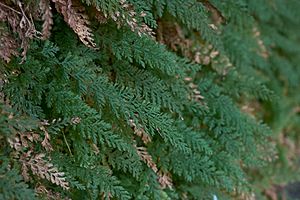Appalachian bristle fern facts for kids
Quick facts for kids Appalachian bristle fern |
|
|---|---|
 |
|
| Conservation status | |
| Scientific classification | |
| Genus: |
Vandenboschia
|
| Species: |
boschiana
|
| Synonyms | |
|
|
The Vandenboschia boschiana, also called the Appalachian bristle fern or Appalachian filmy fern, is a small and delicate plant. It's a type of fern that grows in colonies. It has long, black roots that creep along surfaces. Its leaves stay green all year round.
The common name comes from its leaves, which are very thin. They are only one cell thick! This makes them see-through, like a wet film. The fronds (leaves) are usually 4 to 20 centimeters (about 1.5 to 8 inches) long. They are 1 to 4 centimeters (about 0.4 to 1.5 inches) wide. They are light green and have stems (stipes) that are 1 to 7 centimeters long.
Contents
How the Fern Reproduces
Ferns reproduce using special structures called sori. These are like little packets that hold the fern's spores. On the Appalachian bristle fern, the sori grow along the edges of the frond segments.
Each sorus is protected by a funnel-shaped cover called an indusium. This cover is actually sunken into the leaf tissue. A tiny, bristle-like part sticks out from the indusium. This is common for all Trichomanes species. This fern produces its spores between July and September.
Like all ferns, the Appalachian bristle fern has a special life cycle. It includes a stage called the gametophyte stage. In this stage, the fern grows a tiny, independent plant called a prothallus. Unlike most ferns, which have heart-shaped prothalli, the V. boschiana gametophytes look like tiny colonies of green algae or moss.
About the Fern's Family Tree
Different Types of Chromosomes
Scientists have found that the Appalachian bristle fern can have different numbers of chromosomes. Chromosomes are tiny structures in cells that carry genetic information.
- Ferns in the western parts of their range often have two sets of chromosomes (called diploid).
- Those in the eastern parts usually have four sets (called tetraploid).
- Sometimes, ferns with three sets of chromosomes (called triploid) are found, but these cannot reproduce.
It's thought that many of these fern groups are very old. They might even be genetically identical copies of each other. This means they are like clones that have been around for a very long time!
Where the Fern Lives
The Appalachian bristle fern is found only in eastern North America. It's an endemic plant, meaning it naturally grows only in this area. A small group of these ferns has also been found far away in Chihuahua, Mexico.
In the United States, you can find this fern from southern Ohio in the north down to Alabama in the south. It also grows from Arkansas and southern Illinois in the west to South Carolina in the east. In all these places, the fern groups are very spread out. This is because they need a very specific and uncommon habitat to grow.
Living Environment and Protection
Where it Grows Best
The Vandenboschia boschiana fern loves deep shade. It grows on damp, acidic rocks, often sandstone. You can find it in sheltered canyons, caves, and rock shelters. It usually grows at heights between 150 and 800 meters (about 490 to 2,600 feet) above sea level. These rocky areas are usually found within moist, upland forests.
Why Humidity is Important
This fern needs a lot of moisture in the air all the time. This makes it hard for it to grow in many places in eastern North America today. Scientists believe V. boschiana is a relict species. This means it's a survivor from a time before the last ice age, when the climate was milder.
The fern's current locations show us several things:
- Areas that were not covered by glaciers in the past.
- The type of rock it grows on.
- The kind of bedrock underneath.
- How undisturbed the surrounding forest is.
- The tiny local climate (called a micro-climate).
While very cold weather can harm the fern, temperature is less important than these other factors. However, periods of dry weather can cause many ferns to die. This has reduced the size of many fern groups over the last few decades.
Protecting the Fern
Even though the fern has a G4 conservation status (meaning it's generally secure), it might be more at risk than that suggests. State conservation rankings often list it as Vulnerable (S3) to Critically imperiled (S1). This means it's quite rare and needs protection.
Things that threaten this fern include:
- Its habitat drying out.
- Trees being cut down, which removes the shade over the rocks where it grows.
- Too many people collecting the fern.
Growing and Using the Fern
This plant is not commonly grown by people. Based on where it naturally grows, it might be able to survive in USDA Zone 6. However, this might not truly show how hardy it is, because it usually grows in very sheltered, specific places.
Images for kids



